
As forward-thinking Tokyo is, the idea of classicism still very much permeates many of the city’s institutions. Elegance and efficiency is a pathological expectation, and more often than not, those expectations are met tenfold. This is a large reason why, despite an overwhelming language barrier and high degree of cultural shock (for first-timers anyway), Tokyo is one of the most comfortable destinations in the world for foreign travellers. Some may expect the strong sense of culture would clash with the western sensibilities of the casual traveller, but it’s all balanced impeccably, from the rigid efficiency of the city’s famed public transport to the meticulous dining scene which has seen more Michelin stars than anywhere else in the world. It’s no surprise that this carries on over to Tokyo’s unrivalled luxury hotel scene.
Shangri-La Hotelhas long been one a benchmark of hospitality in Tokyo since it opened in March of 2009, occupying the top 11 floors of the mixed-use Marunouchi Trust Tower Main Building. That much is a given considering Shangri-La’s unimpeachable reputation around the world, but there’s something about the brand’s boutique-minded expression in one of the world’s most unique and famous cities that takes that even further. The end-to-end guest experience here is flawless, from the charming pedestrian entrance that lies a few minutes walk from either the Nihonbashi or Yaesu South exits of Tokyo Station, to the check-in via the dazzling 28th floor lobby, which is a dynamic, palatial scene thanks to masterful paintings, bold carpets, spotless marble floors and elaborate custom-made chandeliers, most of which make reference to distinctive Japanese symbolism.
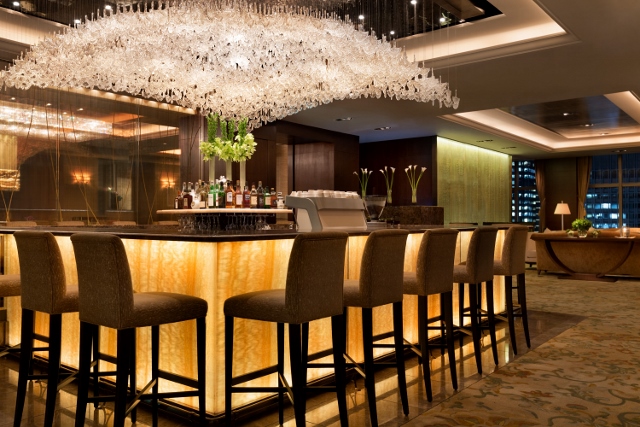
Noise spills from the adjoining Lobby Lounge, which depending on the day would take the form of light chatter from guests or music from a charming pianist. Don’t be surprised if you find yourself thinking of ways to make this your permanent home before you even have a chance to sort your reservation.
It’s in this Lobby Lounge that many find their favourite of the more than 50 grand chandeliers that are located throughout the hotel, most of which were handmade with fine crystals in the Czech Republic by globally-renowned light design and manufacturing company Lasvit. Suspended above the bar is a 2,000kg chandelier by designer Gábriela Náhlíková, made to resemble ginko leaves, which many recognise as the official symbol of Tokyo. Here the usually golden leaves are stripped of colour and presented as translucent reflectors of light, strung together by highly polished stainless steel rods. It’s a graceful sight rivaled only by the nearby 10-metre long chandelier that cascades through the centre of a Grand Staircase between levels 27 and 29; it too was designed in the Czech Republic, this time by Táňa Dvořáková who reportedly took 4,820 hours to complete the intricate wall of sparkling raindrops, designed to look like they are falling from the clouds and sifting through streaks of moonlight. It too weighs 2,000kg but is much more dense, with 486,500 crystal beads and 1,070 hand-blown crystal icicles and optic fibres. Needless to say, a lot of money, thought and detail has made the lobby one of the most exceptional first impressions one could think of.
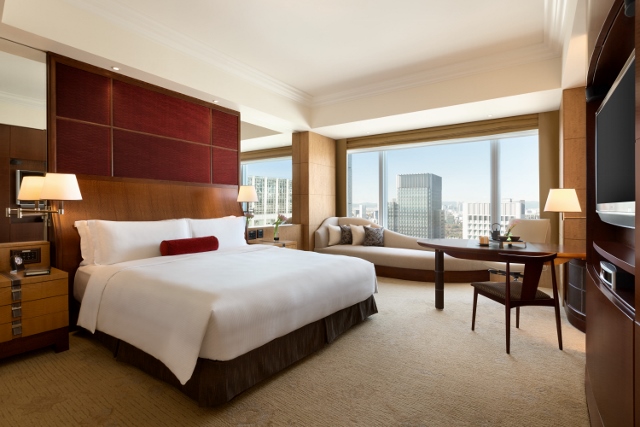
Down the corridor lined with fine art and up to the guest rooms, the lofty expectations set by the lobby are well maintained. My Deluxe Imperial Garden View Room is a jaw-dropping sight on entrance, although that much is to be expected given this is a Forbes five-star. The space is precisely 50 sqm in total, absolutely immersing guests in spacious, luxurious accommodations with fine details grounding all that opulence into something modern and accessible, but still grand and entirely worthy of the hotel’s reputation.
That sense of balance must must be credited to the logical, functional design. This room is a dream to navigate, with everything working in unison. Like most older hotel rooms, this one doesn’t feel outdated when it comes to evolving tech trends. Very few switches are required to blanket the room in complete darkness; there’s a massive 42-inch LCD TV fixed to the wall opposite the bed with a powerful Bose audio system; and the Wi-Fi is blindingly fast, completely free.
Special attention must be given to the bed – it’s wide enough to fit a few people at once, and yet it’s size doesn’t take up the entire room. Comfort is without question; a sky-high thread count guarantees a perfect rest, the mattress is supportive but soft, and the pillows are the type you could sink back in and feel like you’ve just fallen on a cloud. In a typical Tokyo room, this kind of bed would be wall-to-wall, but space is a key strength of the hotel; in fact, here is where you’ll find the largest rooms in Tokyo.
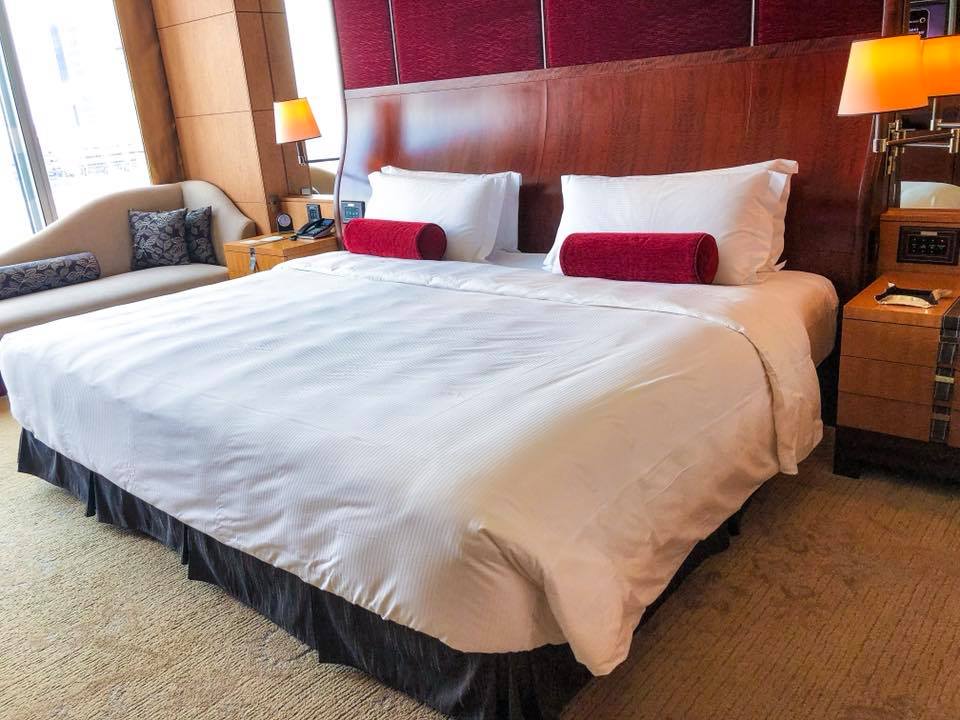
A plush sofa by the window is shaped and sized perfectly so the attention is on that wide-reaching view, brought in through large windows with automatic curtains. Unfortunately there are a few buildings that slightly obstruct the Imperial Garden views, but the Marunouchi Trust Tower is high enough that a lot of the surrounding scene is able to be taken in without issue.
A hardwood working desk basks in the sunlight during the day and is a nice, peaceful spot at night. Like all other furnishings in this room, it looks stylish and mature against the understated wooden interiors and neutral colour scheme, betrayed only by textures of burgundy and gold.
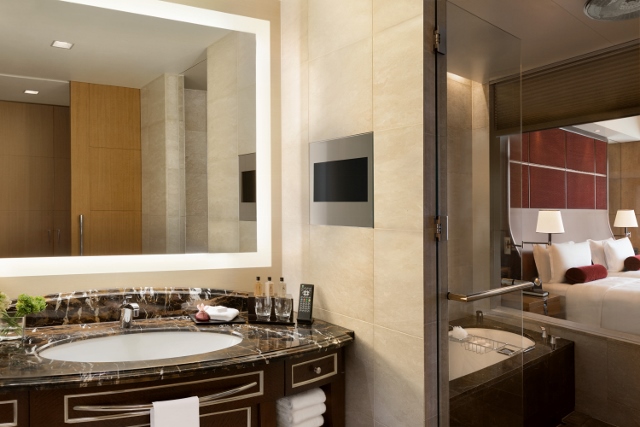
The bathroom is instantly memorable. A separate space is reserved for the high-tech toilet behind a thick glass door, to the guest’s right when facing the impeccable basin. To the left is a large walk-in wet-room featuring a separate rain forest shower (with two modes) and a decently sized bathtub. The shower here is a large selling point for the room, as the wider-than-average head that is fixed to the ceiling releases a stream of water that almost covers the entire room; it’s like you’re standing directly underneath a waterfall, looking out over the room, and the view through a large glass wall that doesn’t layer with fog as soon as you turn the heat up. Don’t worry, there’s an option to obscure yourself.
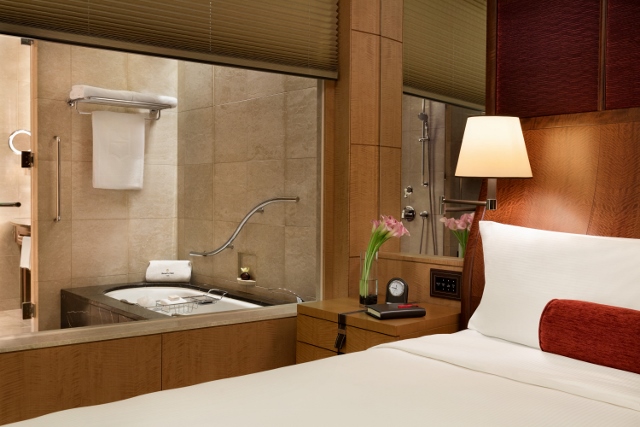
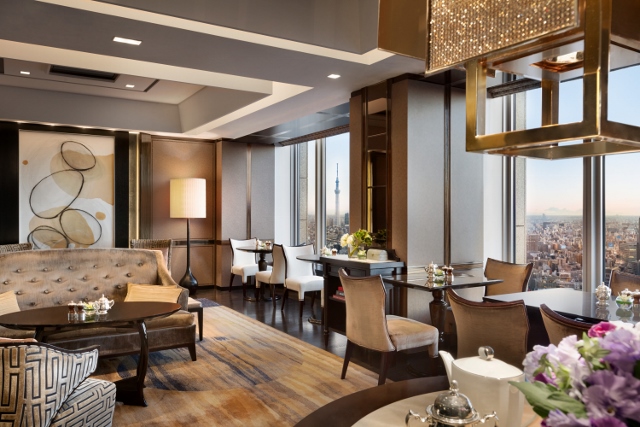
Those who have access to the 37th floor Horizon Club Lounge should take advantage and enjoy a quiet, contemplative breakfast overlooking the expansive cityscape. While the buffet in signature Italian restaurant Piacere is perfectly fine, with premium farm-fresh options, the smaller buffet at the lounge is complemented by a full a la carte menu that reads like pure decadence.
A traditional Japanese breakfast (stewed appetizer, grilled fillet of fish, miso soup, pickles, nori and steamed rice) is available as well as vegetarian and oriental options, but equally valuable here is the list of four Eggs Benedict. Just try and resist the one with a poached egg sitting in the centre of marinated lobster medallion with grilled tomato and caviar, or the one with an incredible white miso hollandaise, tuna flakes, ginger and Japanese spring onion. Other breakfast offerings include several types of pancakes, coconut and chia seed pudding, a soft and sweet Piacere French toast, and a three-egg omelette that can be spruced up with various condiments like potato cake, bacon sausages, and mushrooms. The first page of the breakfast menu is dedicated to showing you exactly where on the map of Japan certain ingredients come from, with the farm-to-table approach translating to exceptional flavours. Best of all, you aren’t limited just one a la carte option, so it’s basically all-you-can-eat. It’s worth noting that many of the a la carte options are also available at Piacere.
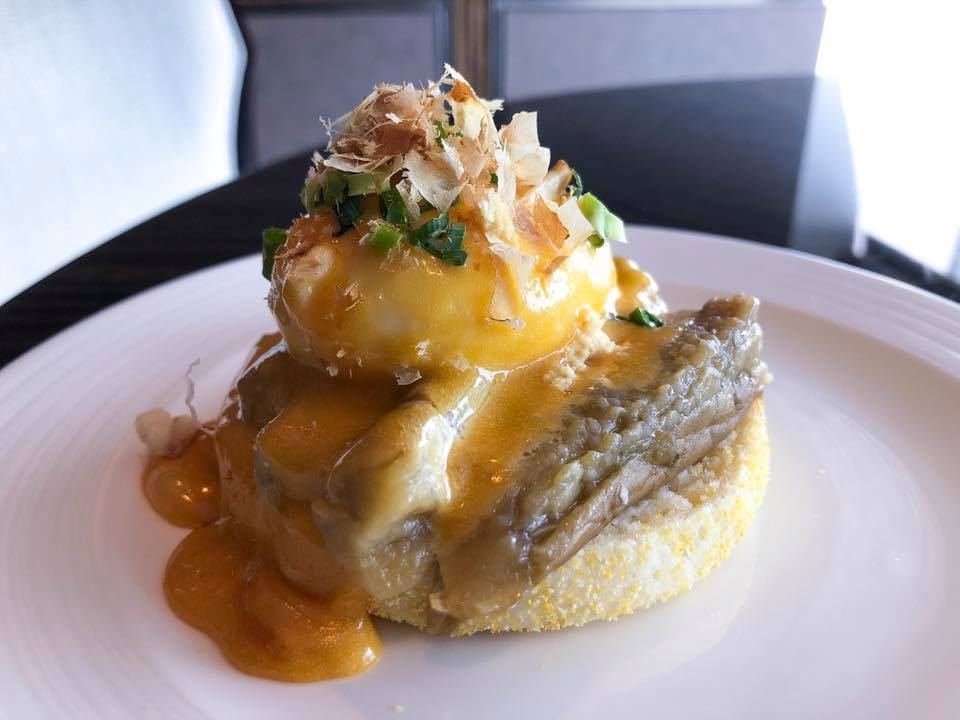
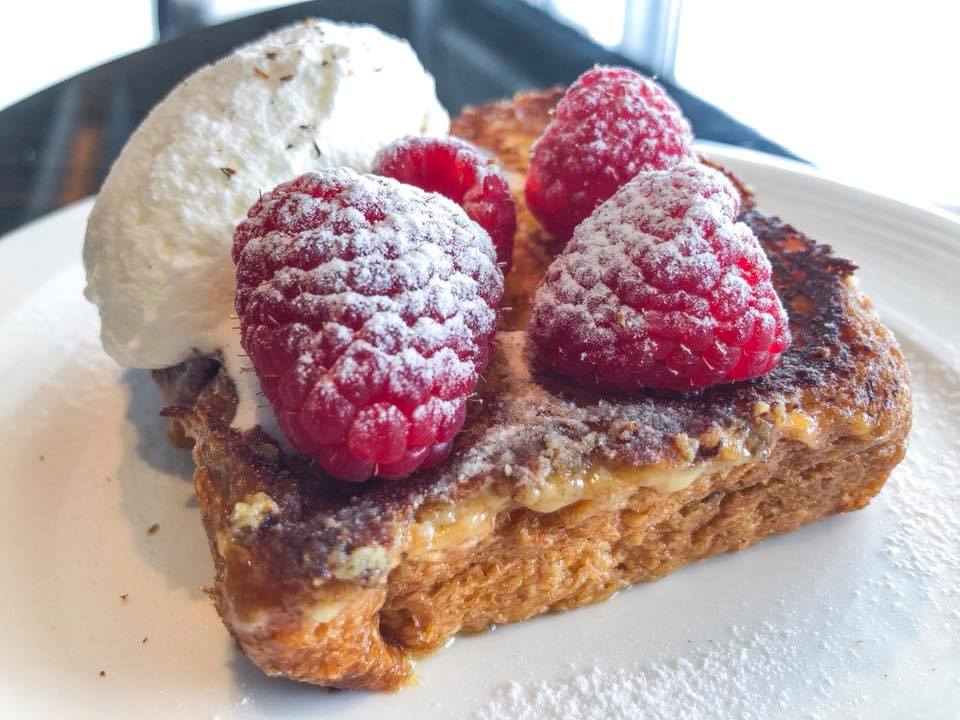
As mentioned above, Piacere is the hotel’s lobby-level Italian restaurant, it too beautified by chandeliers, although these ones have been handmade and crafted in Venice. Executive Chef Andrea Ferrero runs the show here and has put together a menu that reads like a quick whisk away to the peaks and flavours of a European summer. Those who have been to Japan before already know just how much of an affinity local chefs have for technique-heavy cuisines like Italian and French, which is why pushing away from traditional Japanese every now and then isn’t such a bad idea (hint: you’ll likely have the best pizza you’ve ever had outside of Italy while in Tokyo; the best Indian outside of India; the best French outside of France; and so on).
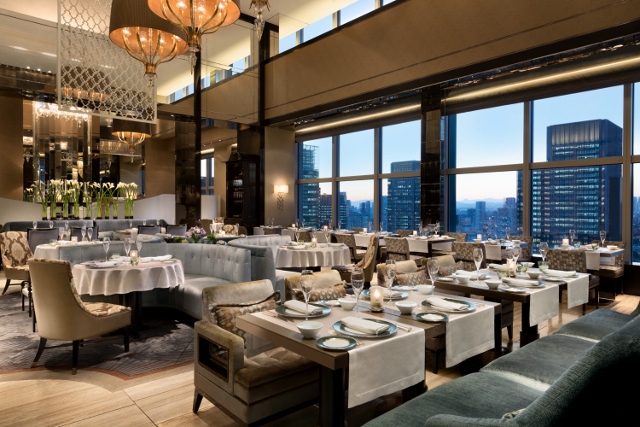
While a chance to tuck into traditional Italian elevated by Japanese techniques and produce is an offer too tempting to pass up, those with little time to spare should instead look to the hotel’s Japanese restaurant Nadaman. The level 29 restaurant is much larger, with a seated capacity of 116 compared to Piacere’s 89, and comes from a legendary restaurant group best known for serving royalty, world leaders and high-end diners since 1830. Perch yourself at the sushi counter for a true seafood feast or take a seat in the main dining hall and just try and stop fawning over the powerful flavours that make up a kaiseki option.
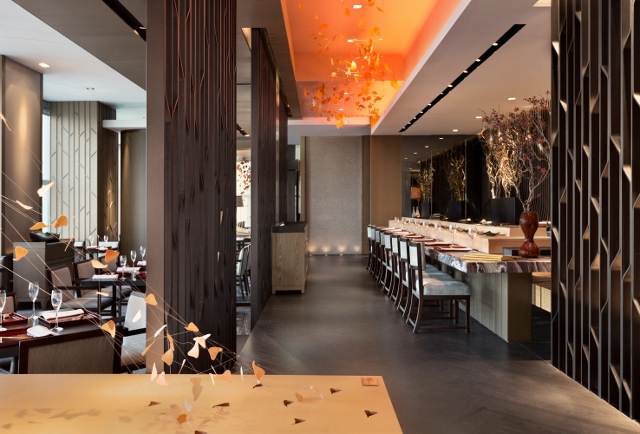
On level 29 guests will find CHI, The Spa, which is as lavishly decorated as you’d expect, with the level of detail one would normally find at a boutique hotel as opposed to a global brand, featuring much character between those moody dark woods. Six spa suites, two treatment suites, and an expensive – though no doubt worthwhile – spa menu features, defined by the use of indigenous Japanese ingredients such as sake pulp, rice bran, natural salts, yuzu and gold flakes. This is also the floor for the hotel’s heated indoor pool and fully-equipped fitness centre.
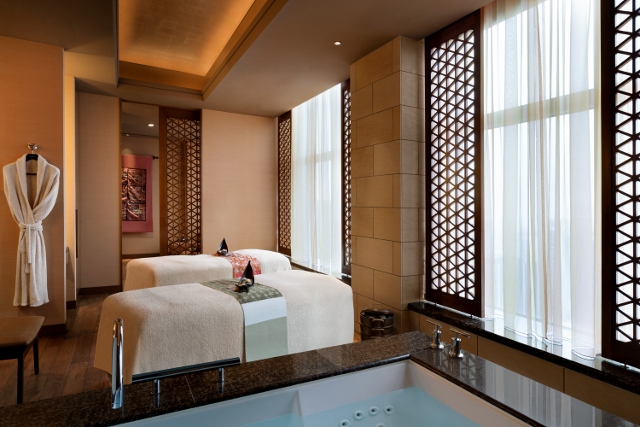
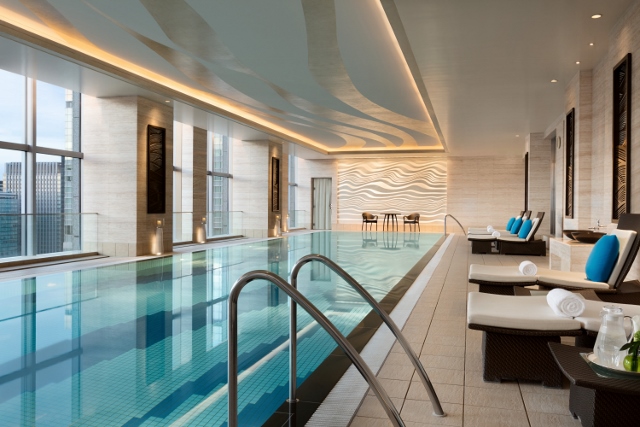
Most valuable, particularly for a Tokyo debut, is a special “meet & greet” service offered by the hotel, via which guests are greeted by a personal guide as soon as they arrive at Tokyo Station. Seeing as this can be one of the most daunting stations in the world to navigate (don’t worry, everyone gets lost at some point) having someone to guide you from the station to your room in just 10 minutes is very handy.
Though after you’ve checked-in, going back out and getting lost isn’t too bad of an idea. The hotel is in the heart of the busy Marunouchi business area, which is surrounded by a high density of things to eat, see and do. Not only do you have the tightly controlled chaos of Tokyo Station at your doorstep, but also the historic Nihonbashi district, high-end Ginza, and the more grounded areas of Yurakucho and Salaryman-favourite Shinbashi. From the station’s famous subterranean “ramen street” (8 of the best ramen shops in Tokyo all with small outlets side-by-side) and Ginza’s luxe shopping to having easy access to both Tsukiji Fish Market (note: it’ll be moving location any month now) and the Imperial Palace, there’s much more to Shangri-La, Tokyo than just what’s inside the actual building.
A bit of a local secret you should keep in mind is the bottom floor of Daimaru, the department store by the Yaesu South Exit which is just a few minutes walk from the hotel. You’ll likely see a queue split into three segments at any time of the day, full of locals patiently waiting (don’t worry, at peak it takes around 30 minutes – short for a Tokyo queue) to load up on N.Y.C Sand. These gooey dessert biscuits aren’t often talked about in Tokyo destination features because they are more something you stumble across by way of curiosity. For Aussie travellers, they are like the Tim Tams of Tokyo, but far more delicate as they are densely layered with rich, indulgent flavours, including some seasonal goodies. Get some as soon as you arrive, just note that they should be refrigerated.
You’re side-by-side with Tokyo Station, and for anyone who has been travelling around Japan before, I don’t even have to reiterate just how valuable that is. With not only the various Shinkansen, but most major metro lines, you have Japan at your doorstep, including easy access to both Haneda and Narita airports via bus. In fact, the bus stop to Haneda is not even a two minute walk from Shangri-La’s door, thought if you have an issue finding it, there will always be someone on the first floor of the hotel to guide you.
It’s difficult to find a negative thing to write about this experience. Nothing about the service feels perfunctory; the rooms are impeccable; the common areas are likely finessed more than once a day to absolute perfection; and the extra services are reminders of just how finely detailed hospitality should be. If price is no issue to you, or if you want to spend one or two nights indulging in luxury between all those capsules and budget hotels – let’s face it, every long-term traveler in Tokyo will need a rest at some point – then in no way should you look past Shangri-La.
Rooms at Shangri-La Hotel, Tokyo start from AUD $729 per night
Shangri-La Hotel, Tokyo
Address: Marunouchi Trust Tower Main, 1-8-3 Marunouchi Chiyoda-ku, Tokyo, 100-8283, Japan
Contact: (81 3) 6739 7888
Website: shangri-la.com/tokyo
The writer stayed as a guest of Shangri-La Hotel, Tokyo.
———-
